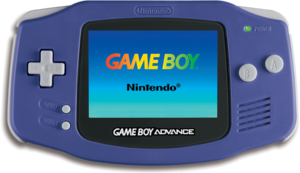Game Boy Advance: Difference between revisions
No edit summary |
ShinyLinoone (talk | contribs) No edit summary |
||
| Line 1: | Line 1: | ||
[[File:Gba.png|thumb|right|Game Boy Advance]] | [[File:Gba.png|thumb|right|Game Boy Advance]] | ||
The '''Game Boy Advance''' | The '''Game Boy Advance''' (Japanese: '''{{tt|ゲームボーイアドバンス|Gēmu Bōi Adobansu}}''' ''Game Boy Advance'') is [[Nintendo]]'s fourth handheld console, and the successor to the Game Boy Color. Two {{se|Mother}} titles ([[Mother 1+2]] and [[Mother 3]]) were released exclusively for this system in Japan. | ||
== | ==Hardware== | ||
The Game Boy Advance is a 32-bit system, and, like its predecessor, could connect with others through a link cable. This, however, was not utilized in any Mother games. The Game Boy Advance supported backwards compatibility, and was capable of playing games for the Game Boy and Game Boy Color. | |||
Another | ==Revisions== | ||
The Game Boy Advance SP, released in 2003, was the first revision of the Game Boy Advance, and made several adjustments to its design and hardware, including a clamshell design to protect its screen from scratches, a rechargeable battery (as opposed to the AA batteries on which the Game Boy Advance ran), and a screen with an integrated frontlight that, when turned on, allows the system to be played without an external light source. In 2005, systems were released that replaced the frontlight with a backlight, allowing for brighter colors. | |||
Another revision for the Game Boy Advance was released in 2005, called the Game Boy Micro. It is much more compact than the first two versions, and features a slightly smaller screen. It removed the processor that allowed the Game Boy Advance to play Game Boy and Game Boy Color games. A limited-edition Mother 3-themed version of the Game Boy Micro was given to those who pre-ordered ''Mother 3''; it is colored bright red and features a pattern of the [[Nowhere Islands]]. | |||
==Mother games on the Game Boy Advance== | ==Mother games on the Game Boy Advance== | ||
*''Mother 1+2'' | *''Mother 1+2'' | ||
Revision as of 19:56, 11 October 2015
The Game Boy Advance (Japanese: ゲームボーイアドバンス Game Boy Advance) is Nintendo's fourth handheld console, and the successor to the Game Boy Color. Two Mother titles (Mother 1+2 and Mother 3) were released exclusively for this system in Japan.
Hardware
The Game Boy Advance is a 32-bit system, and, like its predecessor, could connect with others through a link cable. This, however, was not utilized in any Mother games. The Game Boy Advance supported backwards compatibility, and was capable of playing games for the Game Boy and Game Boy Color.
Revisions
The Game Boy Advance SP, released in 2003, was the first revision of the Game Boy Advance, and made several adjustments to its design and hardware, including a clamshell design to protect its screen from scratches, a rechargeable battery (as opposed to the AA batteries on which the Game Boy Advance ran), and a screen with an integrated frontlight that, when turned on, allows the system to be played without an external light source. In 2005, systems were released that replaced the frontlight with a backlight, allowing for brighter colors.
Another revision for the Game Boy Advance was released in 2005, called the Game Boy Micro. It is much more compact than the first two versions, and features a slightly smaller screen. It removed the processor that allowed the Game Boy Advance to play Game Boy and Game Boy Color games. A limited-edition Mother 3-themed version of the Game Boy Micro was given to those who pre-ordered Mother 3; it is colored bright red and features a pattern of the Nowhere Islands.
Mother games on the Game Boy Advance
- Mother 1+2
- Mother 3
Trivia
- The Game Boy Advance is the only system where all Mother games can be played, though the first two are played only through a port.
